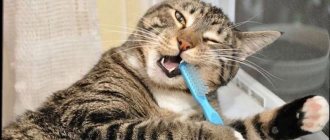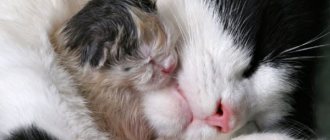5461Administration
1
Hearing is a cat's most important tool for survival in the wild. The structure of a cat's ear is somewhat different from a human's. The animal perceives a much larger number of sounds simultaneously, and is able to determine the distance of objects through hearing. Cats' ears have muscles that can move independently of each other. This allows cats to control their ears like locators, turning them in different directions and picking up any signals around them.
Structural features
A cat's ears consist of three main sections:
- outer ear;
- average;
- internal.
This organ in such animals, as in most mammals, performs a dual function. Firstly, cats' ears are, of course, designed for hearing. This organ also allows animals to maintain balance and determine where is up and where is down.
Auricle
The outer part of the cat's hearing organ, in turn, consists of:
- cartilage;
- entrance to the external auditory canal.
Since the shell of such pets is cartilage, it stands vertically in most cases. On the outside, the outer part of the cat's hearing organ is covered with short hair. The inside of the shell of furry pets is smooth and devoid of hair.
Cats' ears are able to rotate in the direction of the sound source. This is also why cats have excellent hearing. The ears of these animals are located on both sides of the upper part of the head. At the same time, cats are capable of turning them in different directions.
American Curl
A wonderful breed of cats with small ears. The animals are very peaceful, have thick fur, which can be either short or long. The pets are active and love to play, they respond well to training, and can walk on a leash with their owner. They are distinguished by small ears with tassels, which makes cats recognizable.
The nature of the animals is flexible, they get along well with children, are unobtrusive, but enjoy playing with their owner. There is another interesting feature in the structure of a cat's ear. A photo of the animal shows how representatives of this breed have ears that curve outward, making the pets look unusual and even funny.
Anatomy of a cat's ear: structure of an acoustic tube
The opening of the auditory canal leading to the eardrum in such pets is located in the middle part of the base of the shell. The acoustic canal in cats is a cartilaginous hollow tube covered along its entire length with a leathery membrane. The latter, in turn, is capable of releasing sulfur. This substance is necessary for self-cleaning cats’ ears from foreign objects and dust.
In its lower part, the acoustic canal curves and connects with a hollow horizontal section ending in the eardrum. A special feature of the structure of cats' ears, among other things, is the high degree of protection of the acoustic membrane. There is no need to worry about damaging your pet's membrane when cleaning it, for example.
Middle ear
This part of the cat's hearing organ is located in the skull, in the temporal part. It is represented by three aurecal ossicles - the anvil, the malleus and the stirrup. Also part of a cat's middle ear are two muscles. The bones of these animals are connected to the snail. The middle ear of furry pets looks like a membranous tambourine. Vibrations from the membrane are transmitted to the bones and then enter the oval window of the cochlea.
The structure of cats' ears is such that they are able to capture vital sounds well. At the same time, too loud noise in the middle ear of such animals is muffled.
intimate ear
This part of the hearing organ in cats, like in other mammals, is a cochlea or labyrinth. The place of concentration of sound-receiving cells and various auxiliary structures is called the organ of Corti.
Sensory cells in cats are placed in liquid and protected on all sides by a filmy texture. Among other things, they have microscopic protrusions. It is the latter that perceive sound vibrations, and then transmit them to the receptors of the auditory nerves connected to the organ of Corti.
Any breed of cat has three microscopic semi-oval holes in the ear. These formations are filled with liquid and adjacent to each other at an angle. The main purpose of these holes is to balance and maintain balance for the animal. The vibrations of the liquid in them are captured by thin hairs and transmitted by them to the brain, which, in turn, records the position of the body in relation to the horizon.
Mythology[edit | edit code]
In Japanese mythology, cats were most often depicted as bakeneko, a cat endowed with mythical powers [4].
Catwomen are also sometimes depicted as werewolves, but they are nonetheless kind creatures who help people. They are often magical assistants to heroes in myths and legends. Like foxes, cat girls can be very dangerous. In human form they demonstrate superhuman flexibility, agility and cunning. Preserves the cat's body coloring. Also, catwomen in Japanese mythology are beautiful maidens who can transform into cats in exchange for their beauty.
What shape can ears have?
The external auditory organ in most cat breeds is small in size and placed vertically. But in some breeds of these domestic animals the shell has an unusual shape. For example, the structure of the ears of Scottish cats can be called very original. In such animals, the shells are directed forward and seem to hang over the head, fitting quite tightly to it.
There are also breeds with large ears, such as Sphynxes. Curl cats have shells that are completely turned outward. In addition to color, a cat’s ears and tail are what mainly determine its belonging to a particular breed. In any case, no matter what shape the shell of such a pet has, its hearing will be simply excellent. The internal structure of the ears of such pets is the same.
Ear examination
Examination of a cat's ears should be a regular procedure, and the animal should be accustomed to it from a very early age. The pet will get used to it and it will not cause negative reactions in him. The owner should pay attention to factors such as:
- accumulation of sulfur and dirt;
- unpleasant odor;
- blood;
- inflammation and redness;
- wounds and scratches;
- Frequent shaking of ears and head.
The last sign may serve as a signal that the cat has ear mites.
Check the animal's hearing, dirt, odor, discharge, redness and pain. If you notice any symptoms, be sure to contact your veterinarian.
Otitis in a cat: symptoms
The causes of this disease can be injury, ear mites, water getting into the ear, etc. Otitis media in cats manifests itself primarily as itching and excessive secretion of wax. In this case, the animal constantly shakes its head. If the disease is localized in the middle or inner ear, a purulent exudant also appears in the cat's shell.
Otitis media can also be diagnosed by:
- unpleasant odor from the ears;
- high body temperature.
The ears of a cat with otitis media are usually hot. There is also a high probability of suspecting this disease in a pet if it has previously been diagnosed with otodectosis.
Cat ear care
It consists of periodically cleaning the ears with cotton swabs, but this should be done no more than once a week. Care is especially needed for hygienic purposes or if the cat walks outside. Pet owners should have their pet's ears examined regularly. If you notice signs of illness, dark discharge, redness or an unpleasant odor, you should immediately show your pet to a veterinarian.
If the discharge from the ears is odorless and light yellow in color, this is normal, since it is the animal’s protective reaction to the ingress of various pathogens and bacteria. If an animal shakes its head or scratches its ears, this is a dangerous symptom and requires examination by a specialist. There are several reasons that cause ear diseases in cats, and all of them are dangerous to the pet’s health, so owners need to be vigilant and monitor the condition of their pets’ ears.
Treatment of otitis media
In order to alleviate the condition of a pet with this disease, it first needs to clean the sink of scabs and wax. For this purpose, it is best to use tampons soaked in your choice of:
- boric acid;
- peroxides;
- chlorhesidine;
- furatsilin;
- miramistine.
If there is a lot of pus in the cat’s ear or it is located deep, it would be better to take the animal to a veterinary clinic. The specialist will perform the procedure in this case, of course, with the highest quality possible.
To treat otitis media in cats, various types of drugs instilled into the ears can be used. A veterinarian should also prescribe such medications to an animal. The fact is that with otitis media, a cat's eardrum can become like a mesh. In this case, some types of drugs are contraindicated for furry pets.
Most often, the following types of drops are prescribed for instillation into the ears of cats for otitis media:
- "Otovedin."
- "Sofradex".
- "Aurican".
- "Tsipam."
- "Surolan".
For purulent otitis, such animals are also often prescribed antibiotics. These could be, for example, Erythromecin, Spiramycin, Cefazolin.
Modern look[edit | edit code]
Cat's ears
(Japanese 猫耳
nekomimi
, cat ears) or
tail
is an indispensable part of any cat girl. Often the attributes of a neko are shaggy paws, strongly protruding fangs, as well as bells worn on various parts of the body: neck, paws, ears or tail. When an anime or manga character says or thinks something naughty, their mouth is sometimes depicted as looking like a cat's mouth.
"Nya" [edit | edit code]
Frequent use of the interjection "nya"
(Japanese: ニャー) or
“me”
(Japanese: ミャー) - Japanese onomatopoeia of a cat’s meow (analogous to the Russian “meow”), is an equally important attribute of female cats. Also, the character says “nya” in a certain situation or in an arbitrary phrase, denoting his resemblance to a cat or a gentle, sweet, playful behavior. It's worth noting that the use of the word "nya" has become quite popular in anime communities recently.
In the slang of Russian-speaking fans there are also several neologisms derived from “nya”: the noun “nyaka” (from “nya” and “neko”), the adjective “nyashny”, and the greeting “nyak!”.
Symptoms of ear dermatitis
This disease occurs quite often in cats. Ear dermatitis is a group of diseases characterized primarily by symptoms such as redness of the skin and rashes. The reasons for the development of this disease in cats can be, for example:
- parasites;
- allergy;
- injury;
- chemical or thermal burn.
Sometimes dermatitis occurs when an animal takes any medications uncontrolled. Any cat diseases should be treated in strict accordance with the veterinarian’s recommendations.
How to treat food dermatitis
It is as an allergic reaction to any food that this disease occurs most often in furry pets. The ears of both fold-eared cats and ordinary breeds can suffer from dermatitis. Unfortunately, no drugs have been developed that can cure food dermatitis in such animals once and for all. Owners of such a cat just need to carefully monitor what it eats and try to identify foods that cause a reaction. This is quite difficult to do, since quite a long time passes after eating and the first signs of allergic dermatitis. But with a little effort, you will most likely still be able to identify products that are unsuitable for your pet.
How to treat scabies
This disease is caused by mites that fall on the cat's skin through contact with other animals, birds, humans or any objects. To cure a pet, its shells must first be cleaned of scabs and dirt. The structure of a cat's ears is such that this procedure will be very easy.
At the next stage, the affected areas are lubricated with a special preparation. The type of product is chosen depending on the type of mite infesting the cat’s ears. For example, to treat scabies, drugs such as aversectin ointment 0.05%, creolin 3%, cydectin, etc. can be used.
To prevent the development of scabies, owners should limit their cat's contact primarily with stray cats. This is how the tick usually migrates from animal to animal. Owners of cat breeds with large ears should especially adhere to this recommendation. The area affected by such an animal can be very large, causing it to experience significant suffering.
How to properly clean cats' ears
When carrying out a procedure such as cleaning the ears of cats, you must adhere to the following sequence:
- First of all, you need to sit your pet sideways on your lap, and then press his head and whole body to you. If the animal breaks out, you can grab it by the withers or use a towel, wrapping the cat in it as if swaddling a child. After this, you need to clasp the head with one hand so that the pet does not twist it or open its mouth, and with the other hand turn the auricle outward.
- Next, you need to open the animal’s ear and inspect it for the presence of discharge, dirt and redness.
- If strong accumulations of pathogenic contents are detected, you need to take a cotton swab, moisten it in Chlorhexidine, squeeze it well and carefully wipe the inside of the cat’s ear, without going too deep into it.
- When carrying out the instillation procedure, you need to carefully lower the pipette of the bottle with drops two to three millimeters into the ear canal and squeeze out the required amount of medicine, according to the instructions.
- There is no need to release the cat immediately after the manipulation, as it will begin to shake its head violently, which may cause all the medicine to come out.
- It is advisable to gently massage the animal’s ear at the base so that the drops reach their destination.
- If you use cotton swabs to clean your cat's ears, you should not try to push them very deep inside, as this can push the dirt even deeper or damage the passage.
After completing the procedures, it is advisable to pet and praise the animal and give it a treat.










